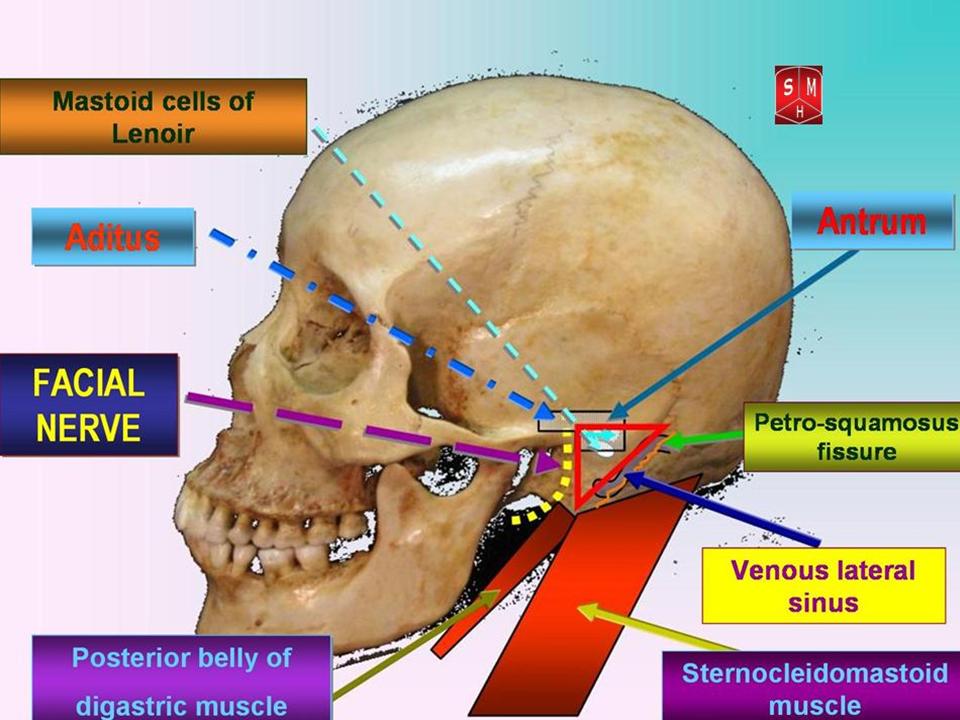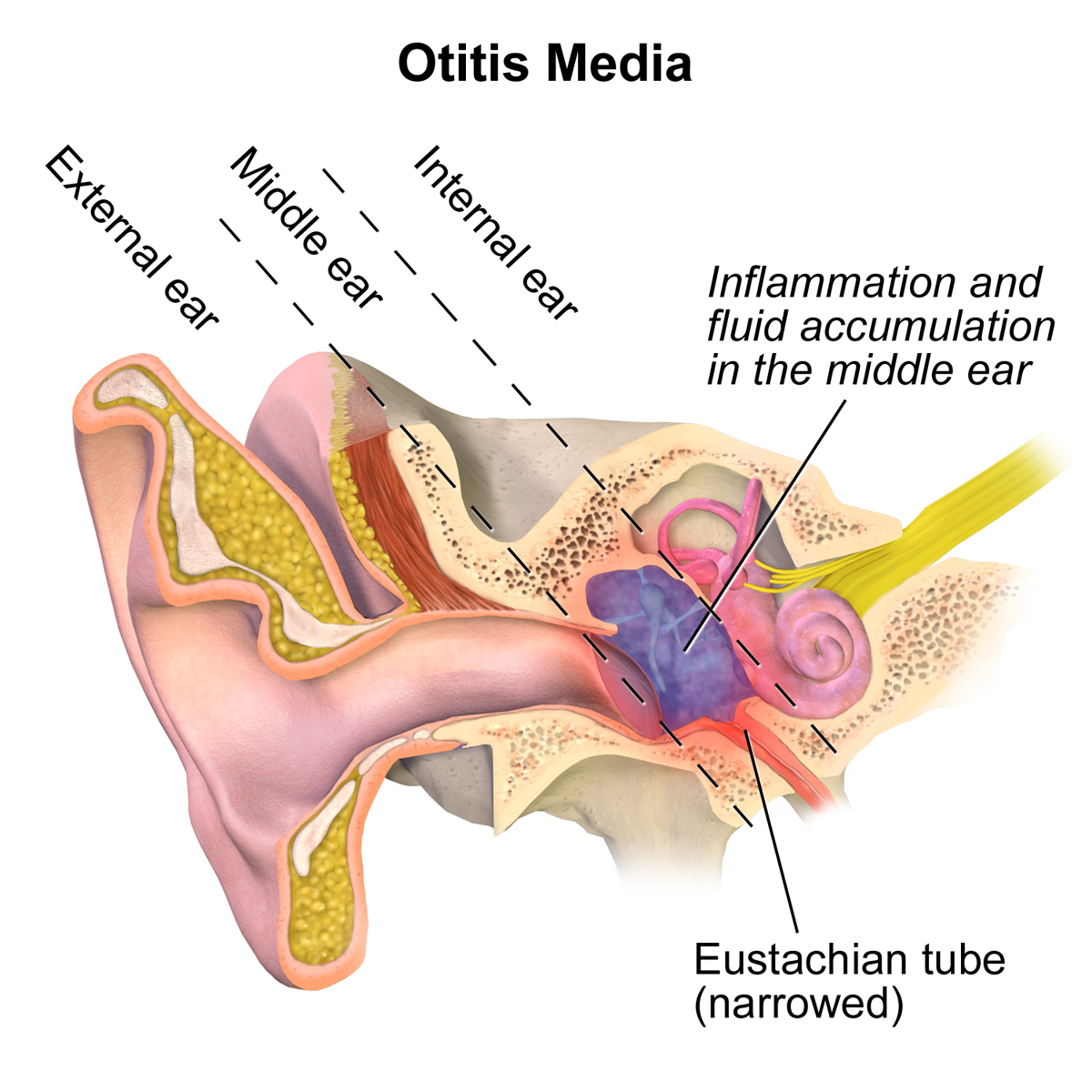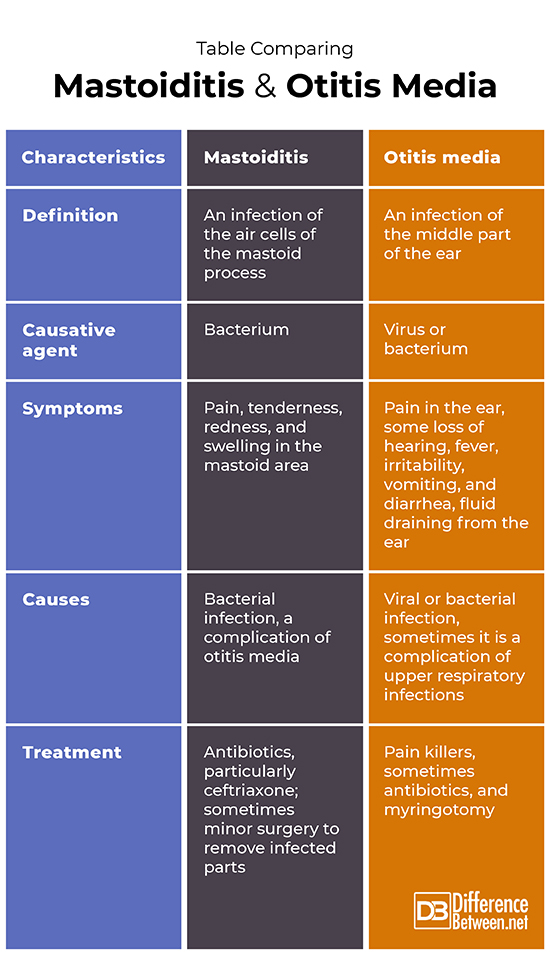Difference Between Mastoiditis and Otitis Media
Mastoiditis is an infection that occurs in the mastoid air cells. Otitis media is an infection that occurs in the middle ear.

What is Mastoiditis?
Definition:
Mastoiditis is an infection of the air cells found in the mastoid bone, which is caused by bacteria and is usually a complication of an ear infection.
Symptoms:
Symptoms include tenderness, pain, redness, and swelling in the region of the mastoid process. Usually, there is also a fever present and the ear is also very painful; symptoms of otitis media will also be present in the case of mastoiditis. There may also be drainage from the ear.
Diagnosis:
The condition is most often diagnosed through a physical examination and noting the symptoms. Imaging in the form of a CT scan can also help diagnose mastoiditis and determine how bad the infection is.
Causes and complications:
The cause of mastoiditis is usually a bacterial ear infection that has gotten worse and spread. The pathogens causing mastoiditis include the same bacterial species as those that cause otitis media; therefore such bacteria as Staphylococcus aureus and Escherichia coli, Streptococcus pneumonia and Haemophilus influenza can all spread and lead to mastoiditis. Several dangerous complications of mastoiditis are possible if untreated, namely, meningitis, and various abscesses in the brain that develop around the dura.
Treatment:
The antibiotic ceftriaxone is often given once a day through an IV for about 14 days. Linezolid and vancomycin are two other commonly used antibiotics, although ceftriaxone is usually the medicine of first choice. If an abscess develops then the region needs to be accessed surgically and infected material removed, including infected air cells.

What is Otitis Media?
Definition:
Otitis media is an infection of the middle region of the ear that is a result of either a virus or a bacterium, and it can develop after an upper respiratory tract infection.
Symptoms:
Symptoms of otitis media include fever, nausea, and diarrhea. There is also a feeling of pain in the ear and the child may have some hearing loss. Babies often become irritable when they have an infection. Children with otitis media also often have fluid draining from the ear.
Diagnosis:
Diagnosis can be made by a doctor using an otoscope to examine the inside of the ear. The eardrum often appears red and swollen when otitis media is present. The doctor may also notice fluid draining from the ear. Otitis media is a common complaint in children, in particular.
Causes and complications:
Various bacteria and some viruses can cause an ear infection, and it can be the result of a secondary complication of an upper respiratory tract infection. The common bacteria to cause the condition include S. aureus and E. coli. Sometimes S. pneumoniae and H. influenzae can cause otitis media. Various other species of bacteria, including Klebsiella sp. and Pseudomonas sp., have also been implicated as potential agents causing these ear infections. Complications of the otitis media include mastoiditis and the complications associated with that condition.
Treatment:
Treatment includes using pain killers such as ibuprofen or Tylenol. The child may also be given a course of antibiotics. Sometimes, doctors do a myringotomy to relieve pressure in the ear. This is when they make a very tiny cut in the eardrum to help drain fluid or relieve the buildup of pressure inside. There is a danger of antibiotic overuse and misuse with ear infections, which is why doctors need to be cautious in how they prescribe medications.
Difference between Mastoiditis and Otitis media?
Definition
Mastoiditis is a condition in which structures called air cells, in the mastoid, become infected. Otitis media is a viral or bacterial infection of the middle ear.
Causative agent
The mastoiditis is caused by a type of bacterium. The otitis media is caused by either a virus or a bacterium.
Symptoms
Symptoms of mastoiditis include tenderness, redness, pain, and swelling in the mastoid area. Symptoms of otitis media include pain in the ear, some loss of hearing, irritability, vomiting, fever, and diarrhea, and fluid draining from the ear.
Causes
Mastoiditis is often a complication of an ear infection, otitis media, and is caused by bacteria.Otitis media can be due to an infection from various bacteria such as S. aureus, E. coli, H. influenzae, or viruses, and it is often a secondary infection that develops after an upper respiratory tract infection.
Treatment
Antibiotics, particularly ceftriaxone, are used to treat mastoiditis, but vancomycin can also be used; sometimes minor surgery to remove infected parts becomes necessary. Pain killers, sometimes antibiotics, and myringotomy are used in the treatment of otitis media.
Table comparing Mastoiditis and Otitis media

Summary of Mastoiditis Vs. Otitis Media
- Mastoiditis is an infection in the mastoid bone of the skull.
- Mastoiditis is a complication of otitis media, which is an ear infection.
- Otitis media is an infection of the middle ear that commonly occurs in children.
- Otitis media can be caused by viruses or bacteria while mastoiditis is due to a bacterial infection that has spread from the ear.
- Antibiotics and pain killers can be used in the treatment of mastoiditis and in some cases of otitis media.
- In both otitis media and mastoiditis minor surgery may be needed to remove infected tissues and relieve the pressure that is causing pain and discomfort.
- Difference Between Rumination and Regurgitation - June 13, 2024
- Difference Between Pyelectasis and Hydronephrosis - June 4, 2024
- Difference Between Cellulitis and Erysipelas - June 1, 2024
Search DifferenceBetween.net :
1 Comment
Leave a Response
References :
[0]Luntz, Michal, et al. "Acute mastoiditis—the antibiotic era: a multicenter study." International journal of pediatric otorhinolaryngology 57.1 (2001): 1-9.
[1]Miyamoto, Richard T. “Mastoiditis”. Merckmanuals. Merck & Co., 2019, https://www.msdmanuals.com/professional/ear,-nose,-and-throat-disorders/middle-ear-and-tympanic-membrane-disorders/mastoiditis
[2]Miyamoto, Richard T. “Otitis Media (Acute)”. Merckmanuals. Merck & Co., 2019,https://www.msdmanuals.com/professional/ear,-nose,-and-throat-disorders/middle-ear-and-tympanic-membrane-disorders/otitis-media-acute
[3]Image credit: https://commons.wikimedia.org/wiki/File:Otitis_Media.png
[4]Image credit: https://en.wikipedia.org/wiki/File:Attack_triangle_in_mastoidectomies.jpg

Good material.